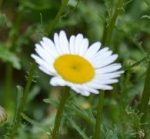 Oxeye daisy is a rhizomatous herbaceous perennial native to Europe and Asia but was introduced to North America and is now found throughout the US where it grows in lawns, vacant lots, pastures, meadows, rangelands, edges of waterways and along roadsides and railroad tracks. Growing 1-3 tall from a rhizomatous rootstock, oxeye daisy has a smooth mostly unbranched stem that carries dark green lobed leaves. The lower leaves have slender petioles, are spoon-shaped and up to 5 inches long while the upper leaves are smaller and clasp the stem. The flower heads are up to 2″ across and are borne singly on the tips of the stems from mid summer into fall. Each flower head consists of fifteen to thirty five white ray flowers surrounding a center of yellow disc flowers and are followed by seed heads of one seeded fruits called achenes. A single plant can produce up to 26,000 seeds, most of which can remain viable in the soil for up to six years. Plants prefer full sun to partial shade and moist soil in USDA Hardiness Zones 3-9
Oxeye daisy is a rhizomatous herbaceous perennial native to Europe and Asia but was introduced to North America and is now found throughout the US where it grows in lawns, vacant lots, pastures, meadows, rangelands, edges of waterways and along roadsides and railroad tracks. Growing 1-3 tall from a rhizomatous rootstock, oxeye daisy has a smooth mostly unbranched stem that carries dark green lobed leaves. The lower leaves have slender petioles, are spoon-shaped and up to 5 inches long while the upper leaves are smaller and clasp the stem. The flower heads are up to 2″ across and are borne singly on the tips of the stems from mid summer into fall. Each flower head consists of fifteen to thirty five white ray flowers surrounding a center of yellow disc flowers and are followed by seed heads of one seeded fruits called achenes. A single plant can produce up to 26,000 seeds, most of which can remain viable in the soil for up to six years. Plants prefer full sun to partial shade and moist soil in USDA Hardiness Zones 3-9
Robin’s Plantain (Erigeron pulchellus)
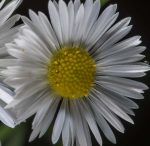 Also known as rose petty, blue spring-daisy, and Robert’s plantain, this herbaceous biennial or short-lived perennial native to eastern and southcentral US from Maine and Ontario to southeast Minnesota south to Florida, Mississippi and Texas where it grows in open woods, fields, streambanks, roadsides and disturbed sites. Plants grow 18-24″ tall and has a rosette of paddle-shaped hairy leaves up to 5″ long with a single flowering stems. This stem is hairy, 12-24″ tall, and bears alternate sessile leaves and loose clusters of 2-9 daisy-like flower heads from mid spring to early summer. USDA Hardiness Zones 3-8
Also known as rose petty, blue spring-daisy, and Robert’s plantain, this herbaceous biennial or short-lived perennial native to eastern and southcentral US from Maine and Ontario to southeast Minnesota south to Florida, Mississippi and Texas where it grows in open woods, fields, streambanks, roadsides and disturbed sites. Plants grow 18-24″ tall and has a rosette of paddle-shaped hairy leaves up to 5″ long with a single flowering stems. This stem is hairy, 12-24″ tall, and bears alternate sessile leaves and loose clusters of 2-9 daisy-like flower heads from mid spring to early summer. USDA Hardiness Zones 3-8
Cow Parsnip (Heracleum maximum)
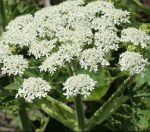
Cow parsnip is a herbaceous biennial native to most of North America where it grows in woodlands, forest openings, grasslands, meadows, stream and river edges, wet ditches,and along roadsides. Plants have a tap root or thick cluster of roots and a stout, hallow, light green stem 4- 8′ tall. The stem has vertical ridges, is usually unbranched, and is covered with white hairs. The leaves are very large and lobed. The iny flowers are carried in terminal flat-headed compound umbels up to 12″ across from late spring to mid summer during the second year. USDA Hardiness Zones 3-8
Hoary Blackfoot (Melampodium cinereum)
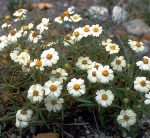 Hoary blackfoot is a herbaceous perennial or subshrub native to Texas. Arkansas, and Colorado where it grows in open sites on sand, gravel, loam, or clay limestone soils. Plants grow 4-8″ tall and have linear-oblong leaves that are pinnately lobed. The daisy-like flower heads are up to 1′ across and appear from winter through spring. They have 7-13 cream colored ray flowers around of center of 25-50 yellow disc flowers. USDA Hardiness Zones 9-11. Photo Credit: Wikipedia
Hoary blackfoot is a herbaceous perennial or subshrub native to Texas. Arkansas, and Colorado where it grows in open sites on sand, gravel, loam, or clay limestone soils. Plants grow 4-8″ tall and have linear-oblong leaves that are pinnately lobed. The daisy-like flower heads are up to 1′ across and appear from winter through spring. They have 7-13 cream colored ray flowers around of center of 25-50 yellow disc flowers. USDA Hardiness Zones 9-11. Photo Credit: Wikipedia
Blackfoot Daisy (Melampodium leucanthum)
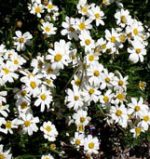 Heat and drought tolerant, this native of the southern Great Plains to Arizona and northern New Mexico, this low growing herbaceous perennial is low growing and forms rounded clumps. The gray leaves are narrow and honey-scented; the white daisy-like flowers have a long bloom season and are attractive to butterflies. Although blackfoot daisies tend to be short-lived, they readily reseed. USDA Hardiness Zones 7-11
Heat and drought tolerant, this native of the southern Great Plains to Arizona and northern New Mexico, this low growing herbaceous perennial is low growing and forms rounded clumps. The gray leaves are narrow and honey-scented; the white daisy-like flowers have a long bloom season and are attractive to butterflies. Although blackfoot daisies tend to be short-lived, they readily reseed. USDA Hardiness Zones 7-11
Wild Quinine (Parthenium integrifolium)
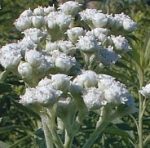 Also called American feverfew, wild quinine is a herbaceous perennial native to eastern North America from Quebec to Ontario, south to Florida and Texas where it grows in prairies, fields, open wooded areas, rocky woods, and hillsides. Plants grow 2-4′ tall and have stiff hairy stems and coarsely-toothed aromatic leaves covered with short bristly hairs. From late spring to mid summer woolly-looking flat topped terminal corymbs of tiny white ray flowers appear. USDA Hardiness Zones 4-8
Also called American feverfew, wild quinine is a herbaceous perennial native to eastern North America from Quebec to Ontario, south to Florida and Texas where it grows in prairies, fields, open wooded areas, rocky woods, and hillsides. Plants grow 2-4′ tall and have stiff hairy stems and coarsely-toothed aromatic leaves covered with short bristly hairs. From late spring to mid summer woolly-looking flat topped terminal corymbs of tiny white ray flowers appear. USDA Hardiness Zones 4-8
Blunt Toothed Mountain Mint (Pycnanthemum muticum)
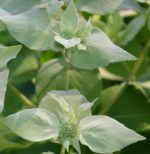 Also called short toothed mountain mint, this herbaceous perennial is native to eastern North American from Maine to Michigan and Illinois, south to Florida and Texas, where it grows in woodlands, fields, meadows and grassy open spaces. Growing 1-3′ tall from a rhizomatous root system, the plant has branched stems with dark green leaves 1-3″ long. The oval leaves have pointed tips, heart shaped bases, toothed margins and a strong spearmint aroma when crushed. From mid to late summer 1/2-2″ wide terminal flat-topped clusters of two-lipped tubular pink appear appear. USDA Hardiness Zones 4-8
Also called short toothed mountain mint, this herbaceous perennial is native to eastern North American from Maine to Michigan and Illinois, south to Florida and Texas, where it grows in woodlands, fields, meadows and grassy open spaces. Growing 1-3′ tall from a rhizomatous root system, the plant has branched stems with dark green leaves 1-3″ long. The oval leaves have pointed tips, heart shaped bases, toothed margins and a strong spearmint aroma when crushed. From mid to late summer 1/2-2″ wide terminal flat-topped clusters of two-lipped tubular pink appear appear. USDA Hardiness Zones 4-8
Narrow-Leaf Mint (Pycnanthemum tenuifolium)
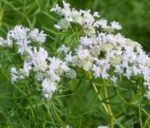 Also called common horsemint, this herbaceous clump-forming perennial is native to eastern US from Maine and Wisconsin, south to South Carolina and Texas where it grows in dry and moist soils in prairies, fields, open woodlands, wet thickets, and along streams and roads. Plants grow up to 3′ tall from a taproot with rhizomes and have thin much-branched stems carrying slender leaves up to 3″ long. From mid to late summer terminal flat topped clusters of small white tubular flowers appear. USDA Hardiness Zones 4-8
Also called common horsemint, this herbaceous clump-forming perennial is native to eastern US from Maine and Wisconsin, south to South Carolina and Texas where it grows in dry and moist soils in prairies, fields, open woodlands, wet thickets, and along streams and roads. Plants grow up to 3′ tall from a taproot with rhizomes and have thin much-branched stems carrying slender leaves up to 3″ long. From mid to late summer terminal flat topped clusters of small white tubular flowers appear. USDA Hardiness Zones 4-8
Virginia Mountain Mint (Pycnanthemum virginianum)
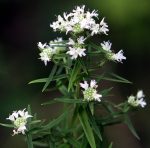 Virginia mountain mint is a herbaceous perennial native to eastern US from Maine and north Dakota, south to Georgia and Oklahoma where it grows in wet prairies, and on stream edges and moist bluffs. Plants grow up to 3′ tall from a rhizomateous root system and have linear leaves up to 2.5″ long and covered with a whitish bloom. From mid to late summer, terminal flat clusters appear bearing up to 50 small white tubular flowers that are 1/8″ long and are 2-lipped. The flower clusters are 3/4″ across and may be spotted with purple dots. USDA Hardiness Zones 3-7. Photo Credit: Wikipedia
Virginia mountain mint is a herbaceous perennial native to eastern US from Maine and north Dakota, south to Georgia and Oklahoma where it grows in wet prairies, and on stream edges and moist bluffs. Plants grow up to 3′ tall from a rhizomateous root system and have linear leaves up to 2.5″ long and covered with a whitish bloom. From mid to late summer, terminal flat clusters appear bearing up to 50 small white tubular flowers that are 1/8″ long and are 2-lipped. The flower clusters are 3/4″ across and may be spotted with purple dots. USDA Hardiness Zones 3-7. Photo Credit: Wikipedia
Purple Cone Flower (Echinacea purpurea forma alba)
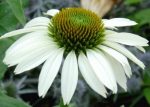 The white form of purple cone flower is an herbaceous perennial native to Central US where it grows in open woods, prairies, and meadows. Stiff stems carry dark green leaves that are four to eight inches long, coarse, and covered with short hairs. The flower heads are produced singly from early summer into fall and consist of greenish-bronze disc flowers surrounded by creamy white ray flowers than are somewhat reflexed. USDA Hardiness Zones 3-8
The white form of purple cone flower is an herbaceous perennial native to Central US where it grows in open woods, prairies, and meadows. Stiff stems carry dark green leaves that are four to eight inches long, coarse, and covered with short hairs. The flower heads are produced singly from early summer into fall and consist of greenish-bronze disc flowers surrounded by creamy white ray flowers than are somewhat reflexed. USDA Hardiness Zones 3-8
Largeflower Valerian (Valeriana paucflora)
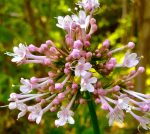 This herbaceous perennial is native to Eastern US from Pennsylvania west to Illinois and south to include Maryland, Tennesee and West Virginia, Kentucky and Alabama where it grows in moist shady habitats such as woodlands, river valleys, flood plains and along streams. It is a member of the honeysuckle family, Caprifoliaceae, that also includes weigelia, abelia, and twinflower. Plants grow 1.5-6′ tall from a fibrous root system occasionally with rhizomes or stolons, and produce basal heart-shaped leaves that are sometimes divided into to 2 lateral leaflets and a larger terminal leaflet. The stems are mostly unbranched and carry opposite pairs of odd-pinnate leaves with 3-7 oval sessile leaflets that are up to 8″ long. From late spring to early summer, terminal panicles of white to light pink funnelform flowers appear. USDA Hardiness Zones 4-9. Photo credit: Wikipedia
This herbaceous perennial is native to Eastern US from Pennsylvania west to Illinois and south to include Maryland, Tennesee and West Virginia, Kentucky and Alabama where it grows in moist shady habitats such as woodlands, river valleys, flood plains and along streams. It is a member of the honeysuckle family, Caprifoliaceae, that also includes weigelia, abelia, and twinflower. Plants grow 1.5-6′ tall from a fibrous root system occasionally with rhizomes or stolons, and produce basal heart-shaped leaves that are sometimes divided into to 2 lateral leaflets and a larger terminal leaflet. The stems are mostly unbranched and carry opposite pairs of odd-pinnate leaves with 3-7 oval sessile leaflets that are up to 8″ long. From late spring to early summer, terminal panicles of white to light pink funnelform flowers appear. USDA Hardiness Zones 4-9. Photo credit: Wikipedia
Mountain Heliotrope (Valeriana sitchensis)
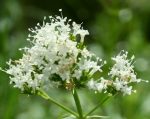 A native of northwestern North America from Alaska and northern Canada to Montana to northern California, this rhizomatous perennial grows in subalpine meadows and moist mountain forests and is also called Sitka valerian. Plants grow up to 3′ tall but may be dwarfed by extreme condition to under 10″ tall. The opposite lanceolate leaves grow so closely they appear whorled and are deeply lobed or pinnately divided with five coarsely toothed leaflets. In late spring or early summer, rounded terminal clusters of white, sometimes pinkish, flowers appear that are tubular, aromatic and have 3 stamens that extend well beyond the 5 petals. USDA Hardiness Zones 3-8. Photo Credit: Wikipedia
A native of northwestern North America from Alaska and northern Canada to Montana to northern California, this rhizomatous perennial grows in subalpine meadows and moist mountain forests and is also called Sitka valerian. Plants grow up to 3′ tall but may be dwarfed by extreme condition to under 10″ tall. The opposite lanceolate leaves grow so closely they appear whorled and are deeply lobed or pinnately divided with five coarsely toothed leaflets. In late spring or early summer, rounded terminal clusters of white, sometimes pinkish, flowers appear that are tubular, aromatic and have 3 stamens that extend well beyond the 5 petals. USDA Hardiness Zones 3-8. Photo Credit: Wikipedia